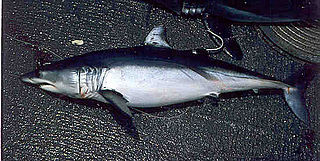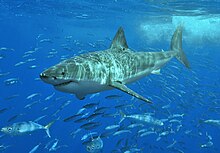
The great white shark, also known as the white shark, white pointer, or simply great white, is a species of large mackerel shark which can be found in the coastal surface waters of all the major oceans. It is the only known surviving species of its genus Carcharodon. The great white shark is notable for its size, with the largest preserved female specimen measuring 5.83 m (19.1 ft) in length and around 2,000 kg (4,410 lb) in weight at maturity. However, most are smaller; males measure 3.4 to 4.0 m, and females measure 4.6 to 4.9 m on average. According to a 2014 study, the lifespan of great white sharks is estimated to be as long as 70 years or more, well above previous estimates, making it one of the longest lived cartilaginous fishes currently known. According to the same study, male great white sharks take 26 years to reach sexual maturity, while the females take 33 years to be ready to produce offspring. Great white sharks can swim at speeds of 25 km/h (16 mph) for short bursts and to depths of 1,200 m (3,900 ft).

A shark net is a submerged section of gillnets placed at beaches designed to intercept large marine animals including sharks, with the aim to reduce the likelihood of shark attacks on swimmers. Shark nets used are gillnets which is a wall of netting that hangs in the water and captures the marine animals by entanglement, however only around 10% of catch is the intended target shark species. The nets in Queensland, Australia, are typically 186m long, set at a depth of 6m, have a mesh size of 500mm and are designed to catch sharks longer than 2m in length. The nets in New South Wales, Australia, are typically 150m long, set on the sea floor, extending approximately 6m up the water column, are designed to catch sharks longer than 2m in length. Shark nets do not create an exclusion zone between sharks and humans, and are not to be confused with shark barriers.

The sand tiger shark, gray nurse shark, spotted ragged-tooth shark or blue-nurse sand tiger, is a species of shark that inhabits subtropical and temperate waters worldwide. It inhabits the continental shelf, from sandy shorelines and submerged reefs to a depth of around 191 m (627 ft). They dwell in the waters of Japan, Australia, South Africa, and the east coasts of North and South America. The sand tiger shark also inhabited the Mediterranean, however it was last seen there in 2003 and is presumed extinct in the region. Despite its common names, it is not closely related to either the tiger shark or the nurse shark.

Gansbaai is a fishing town and popular tourist destination in the Overberg District Municipality, Western Cape, South Africa. It is known for its dense population of great white sharks and as a whale-watching location.

Shark cage diving is underwater diving or snorkeling where the observer remains inside a protective cage designed to prevent sharks from making contact with the divers. Shark cage diving is used for scientific observation, underwater cinematography, and as a tourist activity. Sharks may be attracted to the vicinity of the cage by the use of bait, in a procedure known as chumming, which has attracted some controversy as it is claimed to potentially alter the natural behaviour of sharks in the vicinity of swimmers.
Rodney Winston Fox is an Australian film maker, conservationist, survivor of an attack by a great white shark, and one of the world's foremost authorities on that species. He was inducted into the International Scuba Diving Hall of Fame in 2007. He was born in Adelaide.

The 1992 cageless shark-diving expedition was the world's first recorded intentionally cageless dive with great white sharks, contributing to a change in public opinions about the supposed ferocity of these animals.

Ocean Guardian is the manufacturer of devices that use Shark Shield Technology. The Ocean Guardian electronic devices create an electromagnetic field to deter shark attacks and are used by surfers, scuba divers, snorkelers, spearfishers, ocean kayak fishers, swimming areas off boats and for ocean fishing. It is considered one of the few electrical devices on the market that has performed independent trials to determine the effectiveness at deterring shark attacks, Whilst it is noted the Shark Shield Technology does not work in all situations, new modelling research from Flinders University states that the proper use of personal electronic deterrents is an effective way to prevent future deaths and injuries, it is estimated that these devices can save up to 1063 Australian lives along the coastline over the next 50 years.
Ron Josiah Taylor, AM was a prominent Australian shark expert, as is his widow, Valerie Taylor. They were credited with being pioneers in several areas, including being the first people to film great white sharks without the protection of a cage. Their expertise has been called upon for films such as Jaws, Orca and Sky Pirates.
Andre Hartman is a South African diving guide best known for his work with great white sharks. In a Discovery Channel documentary known as "Great White Sharks: Uncaged" he is filmed free-diving unprotected with several great white sharks.

One of the first shark species to be protected was the grey nurse shark. The biology, distribution and conservation of this species are dealt with in the following paragraphs with a main focus on Australia as it was here it first became protected.

Shark tourism is a form of eco-tourism that allows people to dive with sharks in their natural environment. This benefits local shark populations by educating tourists and through funds raised by the shark tourism industry. Communities that previously relied on shark finning to make their livelihoods are able to make a larger profit from diving tours while protecting the local environment. People can get close to the sharks by free- or scuba diving or by entering the water in a protective cage for more aggressive species. Many of these dives are done by private companies and are often baited to ensure shark sightings, a practice which is highly controversial and under review in many areas.

Isurus is a genus of mackerel sharks in the family Lamnidae, commonly known as the mako sharks. They are largely pelagic, fast predatory fish capable of swimming at speeds up to 50 km/h (31 mph).
Monty Halls is a British TV broadcaster and marine biologist best known for his BBC Great Escape series Monty Halls' Great Escape, Monty Halls' Great Hebridean Escape and Monty Halls' Great Irish Escape, during which he lived and worked in remote parts of the UK and Ireland with his dog Reuben. Halls' other TV programmes include WWII's Great Escapes, Great Barrier Reef and Lost Worlds with Leo Houlding for Discovery Channel.
Enrico Gennari is an Italian marine biologist who specialises in the study of the great white shark.

The following outline is provided as an overview of and topical guide to sharks:
Dolphin Action and Protection Group is a non-governmental organization in South Africa which campaigns for the protection and conservation of dolphins and whales (cetaceans). The group was founded in 1977 by Nan Rice. DAPG has since then broadened its role and activities and has run many national educational and fundraising campaigns. Thousands of educational DAPG pamphlets are distributed each year through schools and libraries and also to fishermen and merchant vessels to prevent dumping of plastics at sea.
South African born Chris Fallows is an expert on great white sharks and their hunting habits. He has amassed the largest database of predatory events involving great white sharks in False Bay and was the first member of the scientific community to observe the breaching behaviour.
Neptune Islands Conservation Park is a protected area occupying most of the Neptune Islands in South Australia about 55 km (34 mi) south-south east of Port Lincoln. It was established in 1967 principally to protect a New Zealand fur seal breeding colony. The conservation park was subsequently expanded to include the adjoining waters in order to control and manage berleying activities used to attract great white sharks. As of 2002, the conservation park is the only place in Australia where shark cage diving to view great white sharks is legally permitted.

Cosmopolitodus is an extinct genus of mackerel shark that lived between thirty and one million years ago during the late Oligocene to the Early Pleistocene epochs. Its type species is Cosmopolitodus hastalis, the broad-tooth mako. In 2021, Isurus planus was reassigned to the genus, and thus became the second species C. planus. However, some researchers still consider both species of Cosmopolitodus as species of Carcharodon.










